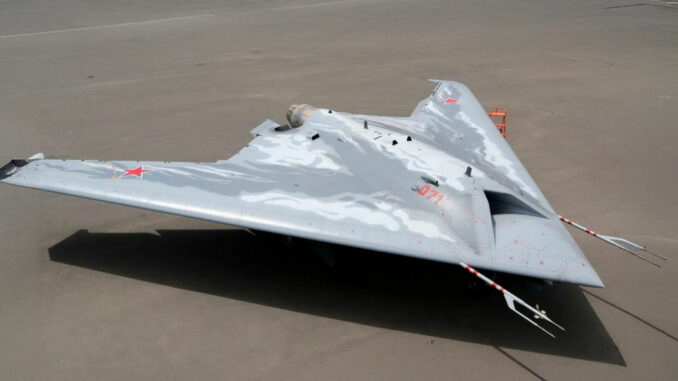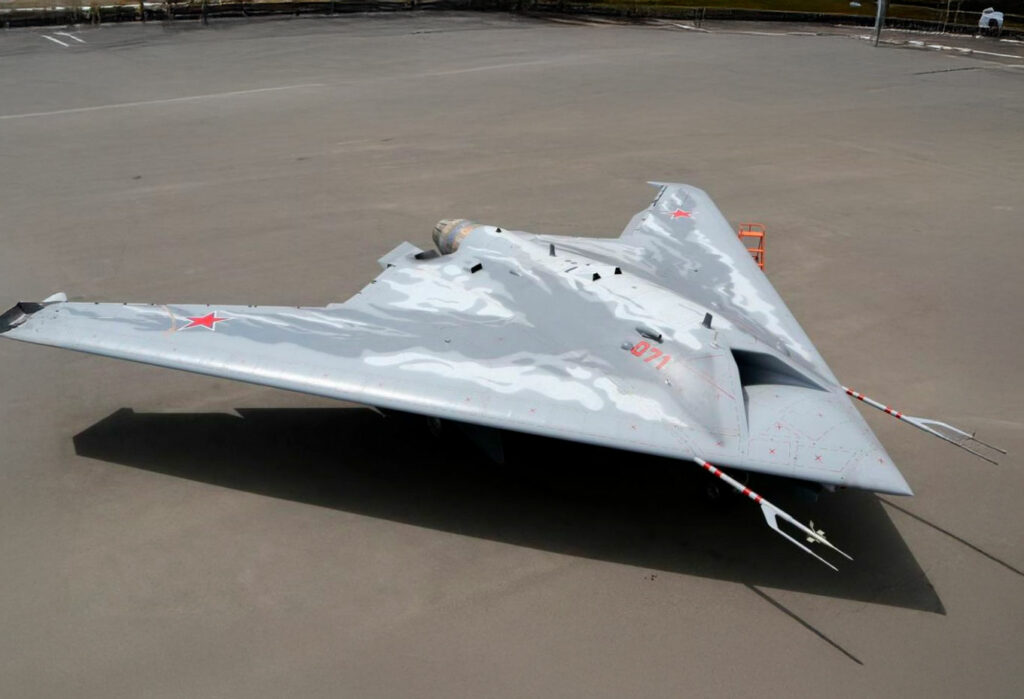
The accidental shooting down of a Russian S-70 drone in Ukraine raises questions about Russian strategies, technological impacts and consequences for the conflict.
A Russian-developed S-70 Okhotnik-B drone has been shot down by a Russian Su-57 over Ukraine. This incident highlights the technological challenges and strategic stakes involved. The S-70, designed for combat and reconnaissance missions with stealth features, was shot down by mistake, probably due to a loss of control. This raises questions about the reliability of Russian technology and the potential consequences for Ukrainian intelligence.
Technical characteristics of the S-70 Okhotnik-B UAV and its operational capabilities
The S-70 Okhotnik-B is a heavy combat drone designed for strike and reconnaissance missions. With an estimated range of 5,000 km, the S-70 can reach speeds of up to 1,000 km/h, carrying high-precision weaponry. With a wingspan of around 20 meters and an empty weight of over 20 tonnes, the drone is designed to operate in tandem with Su-57 fighters, increasing its versatility.
Its stealth capabilities, though limited, enable it to reduce its radar signature, particularly with an exhaust modified to limit thermal emissions. Compared with the MQ-9 Reaper UAVs used by the USA, the S-70 stands out for its ability to operate in cooperative networks with other UAVs and combat aircraft, despite obvious technological limitations.
The friendly fire incident: probable causes and implications
The shooting down of the S-70 by a Russian Su-57 could be attributed to a loss of control, a technical failure, or a mix-up in identification. The context of intense electronic warfare in Ukraine, where jamming systems are frequently employed, could have compromised the communication link between the operator and the drone. In this case, the safest option was to destroy the drone to prevent it from falling into enemy territory, thereby jeopardizing the on-board technology.
This incident illustrates the complexity of operations in conflict zones, where advanced equipment, although powerful, is vulnerable to electronic interference. UAVs like the S-70 are equipped with self-destruct systems, but this functionality can be supplemented by friendly fire to ensure elimination of the aircraft in the event of uncontrolled drift.

The strategic consequences of the loss of the S-70 for Russia and Ukrainian intelligence
The potential capture of S-70 debris by Ukrainian forces represents a major strategic risk for Russia. The electronic components and data collected from the drone fragments could provide military experts with valuable information on the capabilities and weaknesses of Russian technologies. Exploiting this foreign material (FME) could extract critical data on stealth systems, control algorithms and on-board communications networks, thus impacting future Russian operations.
In intelligence terms, this data can be used not only to reinforce Ukrainian anti-drone defenses, but also to adjust electronic countermeasures. The current situation is reminiscent of 2011, when an American RQ-170 drone was captured by Iran, marking a turning point in espionage and electronic warfare.
Analysis of the implications of this incident for the Russian weapons program
This incident could lead to a review of Russia’s drone deployment practices, particularly with regard to field testing. The S-70 program, originally scheduled to be operational in 2024, could see its timetable extended as a result of these failures and the adjustments needed to secure communications in contested areas.
The challenges posed by the incident underline the need for Russia to strengthen its control and communications protocols, particularly in intense electronic warfare environments. Operations on the frontline show that a balance between technological innovation and operational security is crucial, especially when it comes to combat drones likely to operate in highly contested conflict zones.
War Wings Daily is an independant magazine.